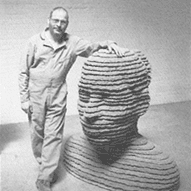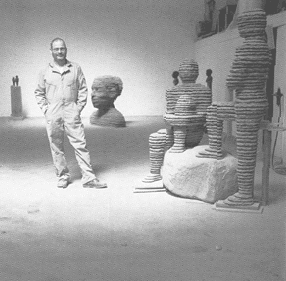|
When I arrived at Boaz's studio on a sunny spring Tuesday morning, he greeted me from a forklift. Maneuvering it around a large boulder on the floor, he pushed it, lifted it, and turned it over, so that he could work with it better. This was a very large boulder, about six feet high and four feet wide. It must have weighed a ton.
Of course, Boaz has significant experience with stone, he's been sculpting and working with it since at least when he arrived to New York in 1975. But it was in 1985 that he stumbled across what he is best known for today: his stone humans, layer upon layer of blue stone in a cascading effect.
The figures are in various poses: sitting, standing, leaning, holding hands, or holding a stone above their heads. The layers create an odd effect; stillness and meditation juxtaposed with a feeling of fluidity and movement. They are organic, alive, and restful. Most of his figures are restive, either sitting or lounging on boulders; a meditative vertical stone garden.
All around his studio (really a warehouse) sit these figures; by themselves or with other figures, positioned next to or on top of boulders, or stand-alone. They are like an extended family for him. He names each one individually. That the names are taken from the Bible is merely a quirk of fate, much like most of his discoveries in art.
Coincidences
While working on the first figures, friends (from his native Israel) would stay with him as guests and he would name his works after whoever happened to be with him at the time. At his first show, someone remarked that all the names were from the Bible. Boaz realized that because of his friends being from Israel, most of their names were from the Bible. It was a complete coincidence, but something Boaz decided to adopt for the rest of his statues.
Or like the day he was living in Soho and they were ripping the sidewalk up in front of his studio. Shards and pieces of bluestone lay everywhere and he began to work with them. They are his signature material today. The bluestone happened to be part of the sidewalk because, well, millions of years ago, New York Harbor is where the glaciers decided to end their journey from the north. The whole metropolitan area is sitting on one gigantic quarry of it. He used what was available.
Or like when he moved his studio to Williamsburg in 1989 (he ran away from the touristy feel that was creeping into Soho for the relative peace and quiet of Brooklyn. "Soho began to not feel like a place for an artist to work, only to show," he explained.) A main sewer line was being laid right through Berry St. and the road was ripped up. There were huge boulders everywhere that were unearthed as the digging proceeded.
Boaz asked if he could have the boulders and the foreman said, "Sure. As long as you can haul them out of here." So Boaz went down to a local used forklift store and bought one on the spot for $3000. He still gets calls all the time from construction crews that dig up boulders. If he likes the boulder and hauls it away, it's his.
So before he even had time to move into his new Williamsburg studio, he had a room full of boulders. He didn1t know what he was going to do with them, but he described finding them as exciting, "like a child playing with pebbles on a beach. Some you just want to take home with you. There's no reason, you just want them."
A few weeks later he found himself still surrounded by these boulders when it began raining. The construction crews were still out front and were eating their lunches. He invited them in.
They began sitting or leaning against the boulders, finding the spot that was comfortable for them, picking the boulders they were attracted to, naturally. "That's when it hit me," Boaz said. "Use the boulders with the statues." Make the connection of man with nature; the same feeling those workers had when choosing what boulder to sit on and where to sit on it. "They had that feeling of wanting to sit right there, right on that spot. It was natural, it was a primal connection; it was not an intellectual decision. That is what I look for."
Consequences
 His work from the beginning has been about the primal connection of man with nature. Growing up on a farm, he learned from his father to use a mule to plow the fields as opposed to a tractor because "the tractor raped the land." His first works incorporated leather, cedar poles, pebbles, and animal hair to create abstract works. When he discovered bluestone, he continued to produce abstract work, until he began to understand the material. His work from the beginning has been about the primal connection of man with nature. Growing up on a farm, he learned from his father to use a mule to plow the fields as opposed to a tractor because "the tractor raped the land." His first works incorporated leather, cedar poles, pebbles, and animal hair to create abstract works. When he discovered bluestone, he continued to produce abstract work, until he began to understand the material.
Layers and layers of sediment being pressurized over millions and millions of years form bluestone. It is no accident that he layers the bluestone for his works. "Nature quarried this stone the same way, in layers. This was formed without the assistance of man. It naturally layers itself. After working with it, I began to get the feeling of those layers and built with the stone in the same way they were formed and found in the earth."
When he first sculpted a human figure, it felt great after all the abstract work he had accomplished. "It felt right, it felt like I was layering myself, and growing," he said. Each work can be seen as representing the layers all of us have, and helped Boaz learn about his own layers, even as he was growing new ones. "I had to grow as an artist. Returning to figures was that step for me. Every artist must grow with his work, or just forget about it."
The sculptures are not necessarily sculptures either; or at least they1re not forced sculptures. True, Boaz does chisel and cut at the rock, but he considers the stone as his partner. "I am not in total control of it, I have to work with it." This is something he thinks many artists are unwilling to do; he stops work when he recognizes the stone is done. "If you have respect for the stone, your work will reflect that respect and adhere to the powers of the stone and of the laws of nature, and be whole."
When he finishes a statue he inserts a steel rod straight through the center of it to solidify the structure. But until he is absolutely, completely done, he relies on natural balance. All those thin layers of stone stacked on each other are resting according to the laws of nature, not Boaz.
Recently he has begun working on his next growth phase: busts. He works from photos of actual people, crafting them in clay and then creating their likeness out of stone. This requires a jump for him; he no longer is creating just a human form, he must work in detail and capture a distinct individual's face. "I gave myself a challenge again and I got excited. The objective of art is the process. I no longer run from project to project; I need to know it fully and explore it before I move on."
Boaz has that luxury. He is one of those rare artists that sells. As a matter of fact, he has sold nearly everything he has made. It's so bad that he can1t mount exhibitions at museums because he doesn1t have enough pieces of his own. So he is beginning to build his own collection. He admits he is a very lucky man to be in that position. He also admits that he gets excited seeing his works displayed still.
He has pieces in museums and public places all over North America, and many right here in New York City. "When my work is in a public place, it becomes alive when people react to it. Art happens when a viewer sees it and that exchange happens. It's amazing how individual a reaction each viewer has and to know I have nothing to do with that anymore. I am merely the catalyst that led to that exchange."
If only he could have seen his own face that morning on the forklift as he was playing with the stones. That exchange showed him still discovering himself and what he loves to do. Watching him play with the stone was like watching a child play with rocks. He was all smiles and intensity, moving it where he wanted, and then letting it lay. Naturally.
|
